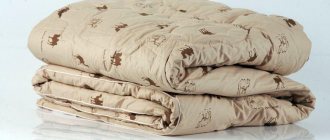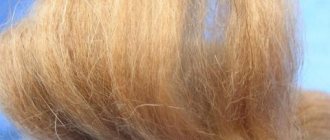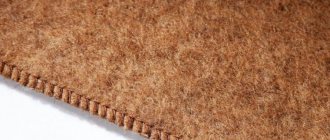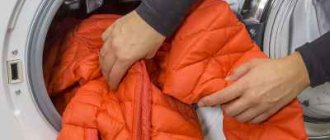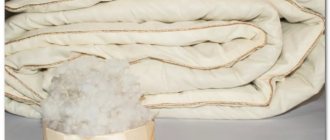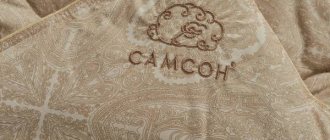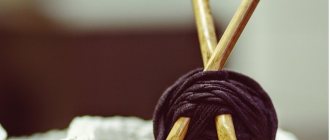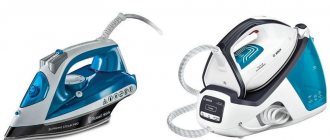Home / Fillers
Back
Published: 06/16/2021
Reading time: 4 min
0
15
Camel wool was popular in the East several centuries ago. Now it is used for sewing bedding, clothing, and warm clothes. A camel wool blanket has healing properties. It is recommended to use it if there are problems with the joints, rheumatism is diagnosed. The fibers of the material are soft, repel dirt, allow air to circulate freely, warm well, and prevent overheating.
- 1 Filler manufacturing process
- 2 Properties: positive and negative
- 3 Which blanket is better, camel or sheep?
- 4 Comparison of camel pillows with other fillers
- 5 Tips for purchasing camel wool products 5.1 Types of tailoring
- 5.2 Range of sizes
- 5.3 Best manufacturers
Types of blankets
Camel wool filling.
You can sleep sweetly under a blanket made of camel wool at any time of the year, be it winter, summer or off-season.
The textile industry is ready to offer a choice of lightweight, regular or all-season options. A lightweight, thin blanket, such as a camel wool blanket, is perfect for summer. In winter, use the regular model. And all-season products are a two-layer construction with the possibility of turning into a single-layer, which is why they can be used at any time of the year.
Based on the manufacturing method, blankets are divided into woven and quilted. Let's look at what each of them is.
- Woven. Open model produced on weaving equipment. Products can be either light or heavy. Weight and softness depend on the quality of the wool. In adult camels it is rough, while in young camels it is softer. The fur of small camels is often used to make small blankets. A woven blanket made of camel wool is also used for purely decorative purposes.
- Quilted. Closed model with filling in a case.
The material from adult camels is prickly. To prevent the wool from pricking, it is covered with a fabric cover and stitched over the entire area. The advantage of such options is a wide choice of colors for the final product.
Models also differ in the type of firmware and filler distribution. They can be:
- quilted;
- cassette;
- Kara-steppe.
Woven.
The quilted option is the most inexpensive of those listed, but has a number of disadvantages. These include weak fixation of the filler, as well as uneven distribution, which over time leads to the formation of lumps. With this method, the stitching is done in parallel lines at a large distance from each other.
The cassette type is more expensive than the previous one. The cover is stitched in the longitudinal and transverse directions, forming cells (cassettes). The advantage of this type of assembly is the high-quality fixation of the filler.
Karostep stitching is a patterned stitch over the entire surface. This option, like the cassette version, holds the filler well, but after a certain time the hairs begin to break through the seams.
Ability to “breathe”
Again, due to the structure of the hair, camel wool products have excellent breathability, so it is almost impossible to sweat under them. In addition, they have a lot of health benefits:
- blood circulation improves, due to this the process of tissue nutrition and metabolism improves;
- toxins produced by the body are neutralized;
- the skin becomes more elastic and elastic, a rejuvenating effect occurs;
- there is protection against electromagnetic fields;
- inflammatory processes occurring in the body are relieved;
- for osteochondrosis, radiculitis and arthritis, relief from pain and discomfort is stimulated.
Which is better - a blanket made of camel or sheep wool?
If you are faced with a choice of which model to buy, made from sheep or camel wool, then weigh their pros and cons. This will help you purchase the best option that will serve faithfully for many years.
The advantages and disadvantages of a blanket made of camel material are discussed above. But when purchasing an item made of sheep wool, you will need to consider the following.
Advantages:
- warm;
- does not change the original shape;
- It's inexpensive.
Flaws:
- twice as heavy as camel down;
- Washing is not recommended;
- Due to the specific smell, regular dry cleaning is required.
What is better, camel wool or sheep wool? As can be seen from the qualitative and practical characteristics, sheep material loses. Even though it is cheaper, a blanket filled with camel hair is still preferable.
It should be noted that both options are considered allergenic, and to prevent the appearance of parasites, in both cases frequent ventilation and dry cleaning are strongly recommended.
Comfort all year round
Camel blankets offer the comfort that other types of wool provide.
Properties of camel blankets:
- Air-permeable, the body “breathes”.
- Keeps us dry and warm. They quickly absorb moisture in large quantities, up to a third of their own weight. The absorbed moisture is removed from the body and evaporates into the air. This is why a person does not sweat.
- Warmer than sheep's wool.
- All-season. You can sleep under such a blanket both in winter and summer. The blanket maintains a comfortable body temperature, regardless of the room temperature.
Which is better - camel hair or bamboo?
To understand which blanket is better to buy - camel or bamboo, you will also need to consider the main characteristics of these products:
- Naturalness. Both options are made from natural raw materials.
- Antibacterial. Bamboo has natural properties to kill fungi and bacteria. Good camel material also has the same qualities, but they are less pronounced.
- Medicinal properties. Camel fur helps with inflammatory processes, rheumatism, joint disease, and improves blood circulation.
- Hypoallergenic. The bamboo model is recommended for people suffering from allergies and asthma. On the other hand, camel material is not recommended in this case.
- Susceptibility to dust mites and moths. Bamboo items do not harbor parasites, which cannot be said about woolen items.
- Care. A bamboo product can be machine washed frequently, but a camel product can only be dry cleaned.
- Weight. Camel is heavier.
- Smells. The wool itself has a specific smell and perfectly absorbs others. Bamboo fiber does not smell of anything.
- Wear resistance. Both products are durable. With proper care they will last a long time.
- Physical indicators. Both options have good breathability, hygroscopicity and thermoregulation.
Which material is preferable - bamboo or camel hair? The qualitative characteristics of each of them are good in their own way. However, those with allergies should opt for the bamboo option.
A little about fibers
To make a cozy blanket, two types of camel wool are used.
Single-humped representatives of this genus (dromedaries) live in the most arid deserts of the world. You won’t be able to get much wool from them, but it has a special golden glow.
Bactrian ships of the desert (Bactrians) live in China, Kazakhstan, and Mongolia. These animals produce up to 10 kilograms of wool. The raw material is considered very soft and thick. It makes excellent insulation and yarn, which is used to make light and warm blankets, pillows, and clothes.
The color of the coat can be beige, brown, or brown. Sometimes cream-colored fibers are found.
How to choose?
How to choose a camel wool blanket that will last for years without losing its original properties? There are a number of parameters that you should pay attention to:
- degree of heat;
- density;
- method of fixing the filler;
- cover fabric;
- type of filler;
- workmanship.
Heat is indicated on the labels in the form of dots and there can be from one to five of them. The warmest is indicated by five dots. Another indicator of heat is the density of the material. For cold rooms in winter, products with a maximum density of 900 g/m2 are suitable. The summer blanket has a density of 160–180 g/m2.
The most reliable method of fixing the filler is considered to be cassette.
The fabric of the cover should be made of cotton materials such as teak, satin, cambric, calico, percale or twill. The fabrics listed are light, durable and breathable. For the manufacture of expensive models, material obtained from eucalyptus fibers is often used.
The filler can be made from the fur of both young camels and adult camels, as well as from their down. The composition of the filler is indicated as a percentage on the label.
Signs of a quality product also include:
- uniform distribution of filler (for closed models);
- uniformity of texture (for open type);
- processing of edges (covering with bias tape or overlock stitching);
- evenness of seams;
- density of the cover.
How to protect yourself from counterfeiting?
Good blankets have always been appreciated and expensive. Therefore, very often there are sellers who try to make money on goods that are in great demand by “sliping” more cheap, usually sheep or synthetic filler, instead of the declared one.
Let's look at the difference between a fake and a quality item:
- By weight. Camel material is much lighter than sheep material.
- In terms of hardness. Natural raw materials are soft, while synthetic ones are rough and hard.
- By color. Wool is difficult to dye, and therefore high-quality products are produced in brown and beige colors.
- By smell. Material made from sheep will have a specific smell, while a synthetic product will have no smell at all.
- To the touch. Sheep material is drier and resembles felt.
- By burning. If you set fire to camel hair, it will not burn, but melt and smell like a burnt feather.
Main Dimensions
Common sizes:
One and a half:
- 140x205 cm;
- 145x205 cm;
- 150x210 cm;
- 155x215 cm;
- 160x220 cm.
Double:
- 172x205 cm;
- 175x205 cm;
- 180x210 cm;
- 200x220 cm;
- 240x220 cm.
Children's:
- 110x140 cm;
- 100x135 cm;
- 100x140 cm;
- 100x150 cm.
European standard:
- 155x215 cm;
- 172x205 cm.
Main manufacturers
Popular and proven Russian manufacturers:
- HitTex;
- OL-tex;
- Elf;
- AlViTek;
- Karakum;
- VulTex;
- Aelita;
- Trinity Worsted Factory.
Foreign companies:
- GOBI (Mongolia);
- Billerbeck (Germany - Ukraine).
The GOBI brand is known all over the world. The company produces only 100% natural products. If you want to buy the best blanket made of camel hair or down, then you can safely choose this brand. And in general, try to choose a blanket whose wool is collected from Mongolian camels.
Price range
How much a product in this category costs depends on its following characteristics:
- filler quality;
- density;
- size;
- forms;
- manufacturer.
If you buy products from well-known brands, you will have to pay a decent price. You should know that a natural and high-quality item cannot be cheap. Therefore, do not buy goods on promotions or sales.
Approximate price range:
- from 1,500 rub. - on a children's bed;
- from 4,000-7,000 rub. — for a single bed;
- from 10,000 rub. - the same size, but made in Mongolia;
- from 11,000 rub. - luxury products.
In most cases, price is an indicator of quality. And if they try to sell you a cheap product by any means, then pass by. The product will probably be of poor quality.
Receiving raw materials
Useful wool is obtained in two ways: during the natural shedding of the animal and by cutting the hair.
The most valuable raw material is fluff obtained through the process of manual combing of the animal. It is so warm that it is used to make special clothing for polar explorers, submariners, and astronauts.
All received wool is sorted and sent to spinning mills. In order to fully preserve all the beneficial qualities of natural material, it is not dyed or bleached.
How to care?
Changing an expensive item is often problematic. Let's look at tips on how to care for a camel wool blanket so that it lasts as long as possible:
- Use a duvet cover to prevent stains.
- Ventilate regularly.
- Remove stains locally with special products containing lanolin.
- Periodically take the product to dry cleaning.
- Store the item in a cotton bag.
- Follow the directions for use on the label.
These tips will help you avoid unscheduled washing, which does not have the best effect on the condition of the garment.
How to wash?
To hand wash a camel wool blanket at home you need:
- Fill the bath with water (t about 30oC).
- Add a special detergent.
- Soak the blanket for several hours.
- Wash, lightly wrinkling it.
- Drain the dirty water and fill the bathtub with clean water.
- Rinse well.
- Hang to drain water, folded in several layers.
- Squeeze carefully.
- Air dry.
Is it machine washable?
You can only wash a small blanket or rug in the washing machine. Large items will not fit in the drum or may overload it. Some recommendations:
- To prevent your washing machine from breaking down, choose the gentle mode.
- Set the temperature to no more than 30oC.
- Add a little detergent so as not to repeat rinsing.
- Do not wring out, otherwise the item may lose its shape.
It’s hard to say which blanket is better to choose. Each model has its own advantages. So the choice is yours.
Features of operation
When using a blanket, it is important to follow the following recommendations to extend the life of the product:
- The healing effect is greater if the wool is in contact with the skin, so for health purposes, a fur or woven blanket can be used from time to time without a duvet cover. However, with constant use, “packaging” is necessary to protect the product from contamination and eliminate the need for frequent washing. The duvet cover should be made of natural fabric with breathable and hygroscopic properties.
- It is recommended to ventilate the cloth twice a year, hanging it in the fresh air in a place protected from the sun.
- Store the product separately from other bedding in a cotton bag.
